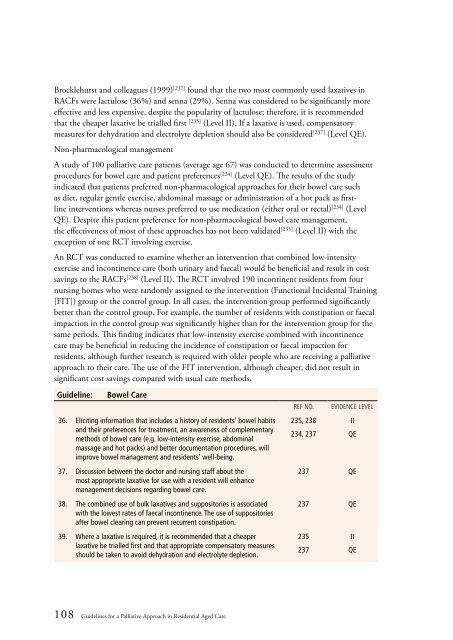Guidelines for a Palliative Approach in Residential Aged Care
Guidelines for a Palliative Approach in Residential Aged Care
Guidelines for a Palliative Approach in Residential Aged Care
Create successful ePaper yourself
Turn your PDF publications into a flip-book with our unique Google optimized e-Paper software.
Brocklehurst and colleagues (1999) [237] found that the two most commonly used laxatives <strong>in</strong><br />
RACFs were lactulose (36%) and senna (29%). Senna was considered to be significantly more<br />
effective and less expensive, despite the popularity of lactulose; there<strong>for</strong>e, it is recommended<br />
that the cheaper laxative be trialled first [235] (Level II). If a laxative is used, compensatory<br />
measures <strong>for</strong> dehydration and electrolyte depletion should also be considered [237] (Level QE).<br />
Non-pharmacological management<br />
A study of 100 palliative care patients (average age 67) was conducted to determ<strong>in</strong>e assessment<br />
procedures <strong>for</strong> bowel care and patient preferences [234] (Level QE). The results of the study<br />
<strong>in</strong>dicated that patients preferred non-pharmacological approaches <strong>for</strong> their bowel care such<br />
as diet, regular gentle exercise, abdom<strong>in</strong>al massage or adm<strong>in</strong>istration of a hot pack as firstl<strong>in</strong>e<br />
<strong>in</strong>terventions whereas nurses preferred to use medication (either oral or rectal) [234] (Level<br />
QE). Despite this patient preference <strong>for</strong> non-pharmacological bowel care management,<br />
the effectiveness of most of these approaches has not been validated [235] (Level II) with the<br />
exception of one RCT <strong>in</strong>volv<strong>in</strong>g exercise.<br />
An RCT was conducted to exam<strong>in</strong>e whether an <strong>in</strong>tervention that comb<strong>in</strong>ed low-<strong>in</strong>tensity<br />
exercise and <strong>in</strong>cont<strong>in</strong>ence care (both ur<strong>in</strong>ary and faecal) would be beneficial and result <strong>in</strong> cost<br />
sav<strong>in</strong>gs to the RACFs [238] (Level II). The RCT <strong>in</strong>volved 190 <strong>in</strong>cont<strong>in</strong>ent residents from four<br />
nurs<strong>in</strong>g homes who were randomly assigned to the <strong>in</strong>tervention (Functional Incidental Tra<strong>in</strong><strong>in</strong>g<br />
[FIT]) group or the control group. In all cases, the <strong>in</strong>tervention group per<strong>for</strong>med significantly<br />
better than the control group. For example, the number of residents with constipation or faecal<br />
impaction <strong>in</strong> the control group was significantly higher than <strong>for</strong> the <strong>in</strong>tervention group <strong>for</strong> the<br />
same periods. This f<strong>in</strong>d<strong>in</strong>g <strong>in</strong>dicates that low-<strong>in</strong>tensity exercise comb<strong>in</strong>ed with <strong>in</strong>cont<strong>in</strong>ence<br />
care may be beneficial <strong>in</strong> reduc<strong>in</strong>g the <strong>in</strong>cidence of constipation or faecal impaction <strong>for</strong><br />
residents, although further research is required with older people who are receiv<strong>in</strong>g a palliative<br />
approach to their care. The use of the FIT <strong>in</strong>tervention, although cheaper, did not result <strong>in</strong><br />
significant cost sav<strong>in</strong>gs compared with usual care methods.<br />
Guidel<strong>in</strong>e:<br />
Bowel <strong>Care</strong><br />
36. Elicit<strong>in</strong>g <strong>in</strong><strong>for</strong>mation that <strong>in</strong>cludes a history of residents’ bowel habits<br />
and their preferences <strong>for</strong> treatment, an awareness of complementary<br />
methods of bowel care (e.g. low-<strong>in</strong>tensity exercise, abdom<strong>in</strong>al<br />
massage and hot packs) and better documentation procedures, will<br />
improve bowel management and residents’ well-be<strong>in</strong>g.<br />
37. Discussion between the doctor and nurs<strong>in</strong>g staff about the<br />
most appropriate laxative <strong>for</strong> use with a resident will enhance<br />
management decisions regard<strong>in</strong>g bowel care.<br />
38. The comb<strong>in</strong>ed use of bulk laxatives and suppositories is associated<br />
with the lowest rates of faecal <strong>in</strong>cont<strong>in</strong>ence. The use of suppositories<br />
after bowel clear<strong>in</strong>g can prevent recurrent constipation.<br />
39. Where a laxative is required, it is recommended that a cheaper<br />
laxative be trialled first and that appropriate compensatory measures<br />
should be taken to avoid dehydration and electrolyte depletion.<br />
Ref No. Evidence level<br />
235, 238 II<br />
234, 237 QE<br />
237 QE<br />
237 QE<br />
235<br />
II<br />
237<br />
QE<br />
108 <strong>Guidel<strong>in</strong>es</strong> <strong>for</strong> a <strong>Palliative</strong> <strong>Approach</strong> <strong>in</strong> <strong>Residential</strong> <strong>Aged</strong> <strong>Care</strong>
















